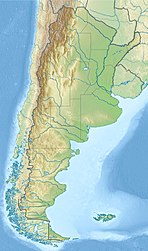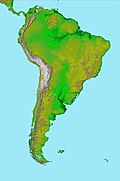Malvinas Basin
Appearance
| Malvinas Basin | |
|---|---|
| Cuenca de Malvinas | |
| Coordinates | 51°30′S 63°30′W / 51.500°S 63.500°W |
| Etymology | Islas Malvinas |
| Location | Argentine Shelf, Southern Atlantic |
| Region | Patagonia |
| Country | |
| State(s) | Santa Cruz Province Falkland Islands |
| Characteristics | |
| On/Offshore | Offshore |
| Boundaries | Río Chico-Dungeness High (W) Scotia-South American plate boundary (S) |
| Part of | Circum-Atlantic basins |
| Area | ~180,000 km2 (69,000 sq mi) |
| Hydrology | |
| Sea(s) | Southern Atlantic Ocean |
| Geology | |
| Basin type | Rift basin |
| Orogeny | Break-up of Pangea |
| Age | Early Jurassic-Holocene |
| Stratigraphy | Stratigraphy |
| Field(s) | non-commercial |
The Malvinas Basin (Spanish: Cuenca de Malvinas) is a major sedimentary basin in the Argentine Shelf offshore southern Patagonia. The basin borders to the west with the Río Chico-Dungeness High that separates it from the Magallanes Basin.[1] The southern boundary is formed by the Scotia plate boundary.[2] Contrary to the neighbouring North Falkland and Magallanes Basins, the Malvinas Basin is not known to have commercial hydrocarbon reserves.[3]
Tectonic history
The Malvinas Basin started to form with the break-up of Pangea since the Early Jurassic.
Stratigraphy
Though poorly understood due to the lack of well data, several formations were identified in the basin on the basis of 2D seismic, of which some also crop out in onshore Patagonia and the Austral Basin:[4]
| Age | Formation | Lithologies |
|---|---|---|
| Neogene | undefined | Claystones and sandstones |
| Paleogene | Arenas Glauconíticas & Magallaniano Formations | Sandstones and claystones |
| Late Cretaceous | Margas Verdes & Arroyo Alfa Formations | Claystones and sandstones |
| Early Cretaceous | Springhill & Pampa Rincón Formations | Claystones and sandstones |
| Late Jurassic | ||
| Middle Jurassic | Tobífera Formation | Volcanics and claystones |
| Early Jurassic | Hiatus | |
| Paleozoic | Basement | Quartzites and shales |
See also
- List of fossiliferous stratigraphic units in the Falkland Islands
- Geology of the Falkland Islands
- Golfo San Jorge Basin
- Antarctic Peninsula



